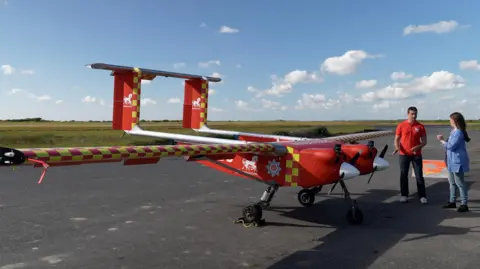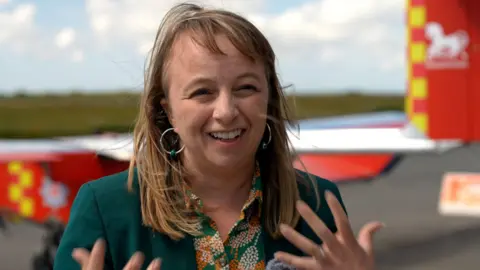 BBC
BBCDrones could soon be working together in swarms to put out flames before they become wildfires, UK researchers hope.
A team of firefighters, scientists and engineers are working on a project they say will allow swarms of up to 30 autonomous planes to spot and extinguish fires by working collectively using artificial intelligence.
Drones piloted by people are already used in firefighting, for example to detect hidden blazes and assess safety risks.
The research is still in the test phase and has not been used on a wildfire, but the team claims it is the first to combine unpiloted drone technology with swarm engineering in the field of firefighting.
The drones that researchers want to eventually use for firefighting are large twin-engined aircraft with a wingspan of 9.5m (31ft) and large water-carrying capacity.
The BBC was invited to an airfield in Cornwall to watch a small-scale swarm trial using one of these along with two smaller test drones. A fire was lit in a bin and the aircraft worked together autonomously to spot it, according to researchers, before mimicking dropping as if to put it out.
The drones are already designed to fly without any intervention from remote pilots, even handling changes in flight conditions themselves.
The next stage – swarm engineering – is about making many robots work together in real world applications, says Prof Sabine Hauert from the University of Bristol, one of the project partners.
“When you look at birds and ants and bees, they can do beautiful, complex behaviours by co-ordinating and so we take inspiration from that to co-ordinate large numbers of robots,” she said.
AI drones working individually and together in swarms open up the possibility of monitoring huge areas the size of the state of California, and detecting and responding to remote fires more quickly, she says.
Similar to how a flock of birds can fly in a co-ordinated manner, a swarm can adapt to changes, so the drones can be deployed long-term, with no gaps in coverage if some have to drop out to refuel, researchers say.

The twin-engine drones were developed by UK company Windracers, whose aircraft are also being tested in Antarctica to help experts forecast the impacts of climate change.
While any real-world use of the technology would need to be approved by regulators, Nickolay Jelev, from Windracer says that the primary aim of the drone swarms would be to prevent fires from turning into infernos.
He added that there would be scope to deter “malicious fire starters” too.
“When you have 20 or 30 [drones] patrolling the skies it would act as a deterrent for people looking to start a fire.”

Most wildfires in the UK are started by human activities, such as using barbecues in the open, the careless disposal of smoking materials or deliberate fires that then grow larger, according to the National Fire Chief’s Council (NFCC).
But because of climate change the UK is seeing longer periods of dry, warm weather, creating the conditions for small fires to become much larger incidents, it says.
The NFCC says that since 2021 there have been over 1,500 wildfires in England and Wales, according to new data from National Resilience, which coordinates the response to significant, serious or catastrophic incidents.

If a swarm of drones can do the work at lower cost with no deaths, that would be a big win, said Prof Stefan Doerr, the head of Swansea University’s Centre for Wildfire Research, who is independent from the project.
But he’s not certain the technology is there yet, with questions remaining about the amount of water or retardant the drones would need to carry to be effective.
“Fundamentally it is an exciting technology and will in the future for sure be part of the solution, but only part of the solution,” he said.
The best part of the solution, he thinks, will be preventative: managing the landscape so that fires don’t become extreme in the first place.




